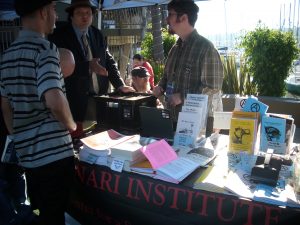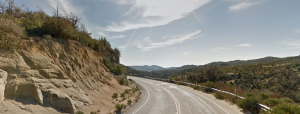Recently while reading Bob Black’s 1997 book Anarchy After Leftism, I was startled to find a citation to Mary Ruwart’s article “Keeping Our Freedom in an Unfree World,” which appeared in the Spring 1996 issue of Formulations, a periodical I edited for the Free Nation Foundation. (The bibliography calls her “Ruhart” [p. 166], but the reference in the main text [p. 73] gets it right.) I had no idea that we were on Black’s radar; I wonder how he came across us?
Tag Archives | Left-Libertarian
Five-Year Plan
“I start with the individual and strike at the state. … Down with the state in all its forms and incarnations: the state of yesterday, of today, and of tomorrow; the bourgeois state and the socialist state.”
— Benito Mussolini, 1920“Our formula is this: Everything within the state, nothing outside the state, no one against the state.”
— Benito Mussolini, 1925
Quotations to keep in mind when alt-right types claim to be libertarians ….
[Sources: First quotation, James H. Meisel, “A Premature Fascist? – Sorel and Mussolini,” p. 16; Western Political Quarterly 3.1 (March 1950), pp. 14-27; second quotation, David D. Roberts, The Totalitarian Experiment in Twentieth-Century Europe: Understanding the Poverty of Great Politics (New York: Routledge, 2006), p. 272.]
Libertopia Plus a Mountain Excursion
As I only now belatedly report, I attended the revived Libertopia conference in San Diego, 3-6 May. As always it was a lot of fun, and I enjoyed getting to hang out with Gary Chartier and Jeff Tucker. It was also fun visiting some of my favourite San Diego eateries, such as Berta’s and Cannonball.
The talk I gave on Hoppe and the Alt-Right will be posted as soon as I have time to finish tweaking it.

Past glory (from 2012)
I’m sad to report that all is not completely well with our beloved Libertopia. The turnout was much lower than usual, and I suspect part of the blame lies with inadequate publicity. Several people one would expect to have been clued in told me they weren’t even aware the event was happening. (The hiccough with the conference originally being announced for a different date and venue surely didn’t help either.) Another cause perhaps lies in the much higher price for an exhibitor’s booth ($1000, up from $400 in previous years); this price hike meant that this is the first Libertopia at which Molinari/C4SS didn’t have a booth, and I’m sure the price kept many other exhibitors away as well. There was also a fair bit of disorganisation; apparently some speakers were comped and some weren’t and it’s not clear what the intended policy was supposed to be. Also, times and venues of speakers were switched without warning at the last minute, so that I missed several talks I’d intended to see. Something really needs to happen to rescue this conference, or we may not see another one for a while.
One of the many attractive features of San Diego is that if you for some reason get sick of being in a cosmopolitan city on the coast, an hour’s drive or so will take you to the mountains or the desert. After the conference I took a free day to head out to the old (but touristed-up) mining town of Julian (check out the town’s webcam), where I haven’t been since childhood. While Julian is a pleasant enough destination (with a nice bookstore), the real point of the trip is the scenery on the way. I recommend doubling the scenery by taking the southern loop there and the northern loop back. For best results, go on a sunny day.
Julian Scenic Drive Instructions:
Southern loop: San Diego to Julian:
1. From San Diego, take I-8 East (a.k.a. the Kumeyaay Highway) for about 40 miles.
2. Take Exit 40 (the sign reads “79 / Descansa / Japatal Valley Rd.”), and after exiting, turn left onto 79 N.
3. Take 79 N for about 20 miles, enjoying the views; you’re in the Cuyamaca Mountains now.
4. Brief recommended scenic detour: On the right you’ll see a sign announcing a “Vista Point.” Take a right onto this short road to Desert View Park, from which (as you might guess) you’ll be able to catch a glimpse of the Anza Borrego Desert far below.
5. Get back on the main road and take 79 N for another three miles or so. Welcome to Julian! Have some lunch. Check out that bookstore (closed Mondays, sorry).
Northern loop: Julian to San Diego :
1. You are probably on either Main Street or Washington Street; their intersection is the center of town. From that intersection, take Washington St. in a southwesterly or downhill direction; the signs should assure you that you’re on 78 W and 79 N.
2. Brief recommended scenic detour: After about a mile on 78 W / 79 N, you’ll see Pine Hills Road on your left. Take it.
After a couple of miles (passing and ignoring Deer Park Road), turn left on Frisius Road.
After a mile and a half, turn left onto (the other end of) Deer Park Road.
Another couple of miles will take you back to Pine Hills Road; turn right and you’ll soon be back at 78 W / 79 N (turn left onto it).
3. Continue on 78 W / 79 N. In about six miles, at Santa Ysabel, 78 W and 79 N will part company; stick with 78 W.
4. In another sixteen miles, in Ramona, you have a choice between continuing on 78 W or taking 67 S – both scenic! One will take you to I-15 S and the other to I-8 W, either of which will get you back to San Diego (about 50 miles from Ramona).
Blast from the Past: 21 Years Ago
[cross-posted at BHL]
I see that a video has recently been posted on YouTube of me, Jacob Levy, David Bernstein, and Richard Geddes on a panel on race, class, and gender at an IHS conference at Dulles Airport in 1997. Buncha young punks.
Who Said This?
While Government is an excellent machine to protect monopoly, has it ever been able to protect us against ill-disposed persons? … In establishing prisons into which multitudes of men, women, and children are thrown for a time in order to come forth infinitely worse than when they went in, does not the State maintain nurseries of vice at the expense of the tax-payers? …
On the other hand, if we analyse all the great advances made in this century – our international traffic, our industrial discoveries, our means of communication – do we find that we owe them to the State or to private enterprise? Look at the network of railways which cover Europe. At Madrid, for example, you take a ticket for St. Petersburg direct. You travel along railroads which have been constructed by millions of workers, set in motion by dozens of companies; your carriage is attached in turn to Spanish, French, Bavarian, and Russian locomotives: you travel without losing twenty minutes anywhere, and the two hundred francs which you paid in Madrid will be divided to a nicety among the companies which have combined to forward you to your destination. This line from Madrid to St. Petersburg has been constructed in small isolated branches which have been gradually connected, and direct trains are the result of an understanding which has been arrived at between twenty different companies. Of course there has been considerable friction at the outset, and at times some companies, influenced by an unenlightened egotism, have been unwilling to come to terms with the others; but, I ask, was it better to put up with this occasional friction, or to wait until some Bismarck, Napoleon, or Zengis Khan should have conquered Europe, traced the lines with a pair of compasses, and regulated the despatch of the trains? If the latter course had been adopted, we should still be in the days of stage-coaches.
The network of railways is the work of the human mind proceeding from the simple to the complex by the spontaneous efforts of the parties interested, and it is thus that all the great enterprises of our age have been undertaken. …
What thousands of examples one could cite in support of this same idea! Take all great enterprises such as the Suez Canal, the lines of Atlantic steamers, the telegraph which connects us with North and South America. Consider also that commercial organisation which enables you on rising in the morning to find bread at the baker’s … and all other things that you want at other shops. Is this the work of the State? …
If we closely scan the development of the human mind in our times we are struck by the number of associations which spring up to meet the varied requirement of the individual of our age – societies for study, for commerce, for pleasure and recreation …. To make a list of the associations which exist in Europe, volumes would be necessary, and it would be seen that there is not a single branch of human activity with which one or other does not concern itself. The State itself appeals to them in the discharge of its most important function – war; it says, “We undertake to slaughter, but we cannot take care of our victims; form a Red Cross Society to gather up the wounded on the battle. field and to take care of them.”
Let others, if they will, advocate industrial barracks, or the monastery of Authoritarian Communism; we declare that the tendency of society is in an opposite direction. We foresee millions and millions of groups freely constituting themselves for the satisfaction of all the varied needs of human beings – some of these groups organised by quarter, street, and house; others extending hands across the walls of cities, over frontiers and oceans.
Radical Tea
Things that don’t exist, but should:




